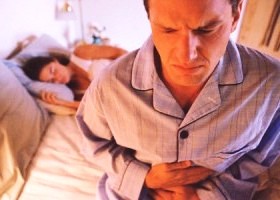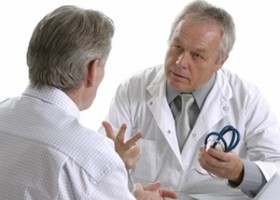December 26, 2012
- Treatment of mastitis
- Anal fissure
- Acute appendicitis
- Acute forms of periodontitis
Pilonidal sinuses (a disease also has other names - cyst epithelial coccygeal . tailbone cyst . coccygeal fistula . pilonidal sinus ) - A congenital defect of character. It manifests itself in the soft tissue sacrococcygeal area. This disease generally causes discomfort to people younger: doctors often treat patients aged 15 to 30 years. Often it is seen in male patients.
Causes
A person suffering from this disease, a strictly middle gluteal line approximately 4-7 cm from the edge of the anus there is a hole. Sometimes it is almost imperceptible, as a point, but in some cases, the opening may be broad enough to look like a well-marked crater. This is the beginning of a hole and coccygeal. The course ends blindly into the subcutaneous tissue, it is not associated with the sacrum and coccyx. In fact, this hole is a gateway for infection.
It often happens that a man lives many years with the disease and does not imply its availability. Until the inflammation and all its consequences, periodic small allocation may not care about the patient.
Obvious symptoms appear in humans after infection penetrates through the hole. This often occurs as a consequence of the coccyx injury, severe hypothermia, suffering Flu . Sometimes it occurs without apparent cause. Because of these factors, says the expansion of epithelial coccygeal, can break down its wall, gradually developing an inflammatory process in the sacrum and coccyx. The inflammation is turned on and fatty tissue.
Symptoms
With the development of inflammation man celebrates the manifestation of pain in the area of the coccyx he manifested swelling, redness in the area of the hole, which sometimes extends to the side of it. This inflammation usually causes a person to seek medical help. In these manifestations diagnosed acute form of the disease. In the presence of abscess in the region where the coccygeal moves, it can reveal themselves. If during this period practiced treatment of epithelial coccygeal, then such an operation carried out by experts. After that, the pain subsides, the patient feels much better. However, later on the spot where the hole came to light, forming a secondary fistula, which can be observed periodically fester. If the patient has formed a fistula, the pain bothers him occasionally, in addition, constantly observed allocation, complicating the daily hygiene. Furthermore, the site of inflammation may eventually develop cyst , Besides possibly malignancy tumor . So finally solve the problem will only excision of coccygeal via surgery.
However, in some cases after abscess sacrococcygeal region was opened a doctor, or it happened on their own, the wound is closed for a while entirely. Yet the body is present in foci of chronic infection in the epithelial coccygeal passages. Over time, this leads to a re-aggravation of the disease and the re-emergence of an abscess. Sometimes this place is developed phlegmon . Such exacerbation sometimes occurs after a few months, in some cases, the period of prosperity may last even several years. Even between people exacerbations notes the existence of some of the symptoms: disturbed his dull pain that occur from time to time. While sitting often discomfort in the coccyx. Sometimes there are small allocation.
Thus, guided by clinical specialists to distinguish between uncomplicated and complicated purulent process pilonidal sinuses.
In complicated form of the disease is marked acute and chronic During the illness, as well as periodically observed periods remission .
If the discharge from the coccygeal not occur promptly, the patient may appear painless infiltration Having sharp contours. Man feels his movements at the time, feeling uncomfortable. If infection occurs stroke, thereby developing acute inflammation, then the person can greatly increase the body temperature.
If the patient says chronic disease, significant changes in the general condition of not. No redness, swelling at the site of the lesion, selection poor. In place of the secondary holes appear scar tissue changes.
For a period of remission is characterized by closing the hole scars, with pressure on the primary discharge openings are not observed.
Complications
If the patient ignores the long-term symptoms and persistently refuses treatment, the changes in the coccygeal course, which arise under the influence of the inflammatory process, leading to the emergence of several secondary fistula . Typically, these fistulae are formed away from the primary site of the lesion. Sometimes they occur in the sacral-coccygeal region, may also appear on the scrotum, inguinal folds at the crotch. With this development of the disease, it is often compounded by pyoderma , and fungal lesions . Such complications are significantly aggravate its course. During the operation of such patients excision of tissue is performed on a relatively large area, wherein, the operation is sometimes impossible to carry out in one step.
As previously mentioned, another severe complication coccygeal, long time not being treated, is the transition to a malignant form of the disease. This complication is relatively rare, but it is sometimes the case.
Diagnostics
 The process of diagnosis presents no particular difficulties for professionals. The main feature on which the diagnosis is established and is characteristic of the localization process. Addressing to the doctor, the patients tend to complain about the pain of a different nature and intensity in the vicinity of mezhyagodichnoy folds, and also note the presence of purulent discharge from the fistula. Another important diagnostic feature - the presence of primary sinus openings. Links fistula rectum in this case is not found.
The process of diagnosis presents no particular difficulties for professionals. The main feature on which the diagnosis is established and is characteristic of the localization process. Addressing to the doctor, the patients tend to complain about the pain of a different nature and intensity in the vicinity of mezhyagodichnoy folds, and also note the presence of purulent discharge from the fistula. Another important diagnostic feature - the presence of primary sinus openings. Links fistula rectum in this case is not found.
During inspection of the lesions the doctor performs a digital rectal examination, as well as the anal canal, to rule out other illnesses. Through the rear wall of the rectum palpable as sacral and coccygeal vertebrae to determine the presence or absence of change.
During diagnostics specialist sometimes experiencing some difficulty in trying to distinguish between tunnels and adrectal coccygeal fistulas. This occurs when the primary apertures are located very low to the anus.
Errors in diagnosis may occur in the event that there are suppurative complications. In this case, the physician can not only suspect adrectal fistula But sharp paraproctitis . osteomyelitis of the coccyx . When setting wrong diagnosis practiced the wrong approach to treatment. Accordingly, the risk of complications and the transition to an advanced form of the disease.
It is also important to differentiate from pilonidal sinuses cyst . pyoderma with fistulas . rectal fistula . Therefore, in the process of diagnosis is mandatory investigations sigmoidoscopy and sensing coccygeal.
Treatment
 Patients should be aware that in the presence of epithelial coccygeal heal illness will only conduct surgery. Therefore, the treatment of this disease is carried out only surgically . During the surgery removed the source of inflammation - epithelial channel and all of the primary holes. Also, if necessary, modified excised tissue in the coccygeal and secondary fistula. The question of timing, as well as the methods of surgery experts consider taking into account the clinical classification of the disease.
Patients should be aware that in the presence of epithelial coccygeal heal illness will only conduct surgery. Therefore, the treatment of this disease is carried out only surgically . During the surgery removed the source of inflammation - epithelial channel and all of the primary holes. Also, if necessary, modified excised tissue in the coccygeal and secondary fistula. The question of timing, as well as the methods of surgery experts consider taking into account the clinical classification of the disease.
If a person is diagnosed with uncomplicated epithelial coccygeal ho with the primary holes, but without the presence of inflammation, the operation is carried out in a planned manner. Before the surgery, stroke stain through the primary holes, and then excised. In this case, after the operation remains relatively neobshirnaya wound hence not strongly stretched fabric after tightening the sutures. In this case, you can sew up the wound entirely.
Patients with acute inflammation coccygeal operation is conducted, at which stage must take into account, as well as extensive inflammation.
If infiltration is not beyond the mezhyagodichnoy folds performed radical surgery, during which the excised coccygeal course and the primary holes. However, the use of a blind seam in this case is not practiced.
When distributing infiltrate beyond mezhyagodichnoy folds originally applied several conservative methods aimed at reducing infiltration. To do this, held daily warm baths, ointments are applied on the basis of a water-soluble ( levomekol ) Practiced physiotherapy. After reducing the infiltration is performed radical surgery.
If a patient is diagnosed an abscess, that radical surgery is performed immediately. During the course of the operation is excised, and the wall of the abscess. If the patient holds extensive infected wound, it will heal relatively long time, and after the healing remains rough tripe . To avoid this, in acute inflammatory process operation is sometimes carried out in two stages. Originally performed an autopsy abscess, his daily rehabilitation and treatment aimed at eliminating the extensive inflammation. Several days later a second step operation. Doctors do not recommend otstrachivat radical operation for a long period, since over time, can develop complications of the disease.
In chronic inflammation of the coccygeal carry out elective surgery, but the patient should be observed exacerbation. The operation is carried out with full anesthesia, which is used for epidural-sacral anesthesia . With simple interventions sometimes practiced by local anesthesia. The duration of the operation - from 20 minutes before 1:00 .
The postoperative period
When radical surgical intervention at any stage of the disease, doctors give a favorable prognosis. Typically, patients tolerate the operation is easy, and after a few weeks recovering disabled patient and the wound heals in about a month. Suture removal is carried out by about the tenth day. After surgery to normalize the condition of the patient is in the hospital, where he provided anesthesia. It is important to observe a specialist before a final recovery. Prior to the complete healing of the wound it is necessary to shave the hair on the edge of the wound. Do not sit, and lift weights before the wound is completely healed.
In the first months after the operation the patient is not recommended to wear tight clothes with tight joints to prevent injuries. It is important to carefully follow all the rules of hygiene. Need regular careful washing and daily change of linen. It should be of cotton.
No comments:
Post a Comment